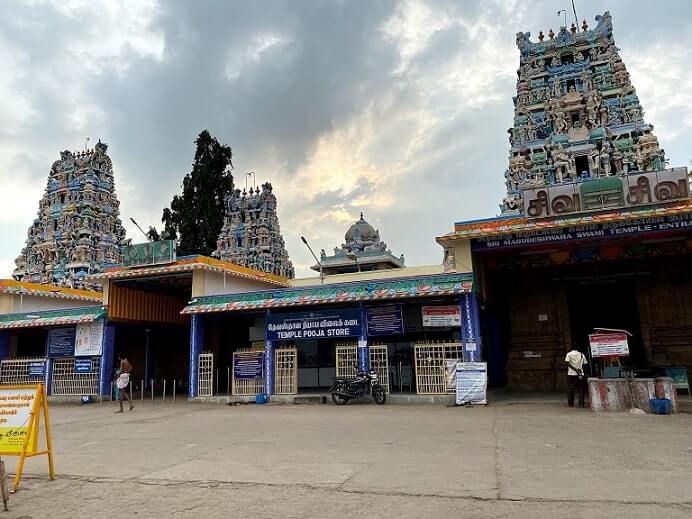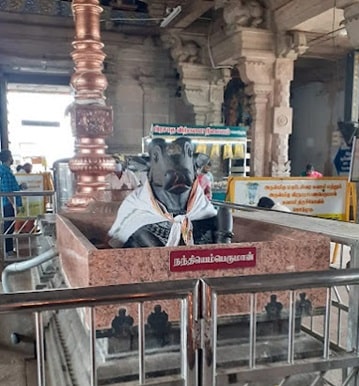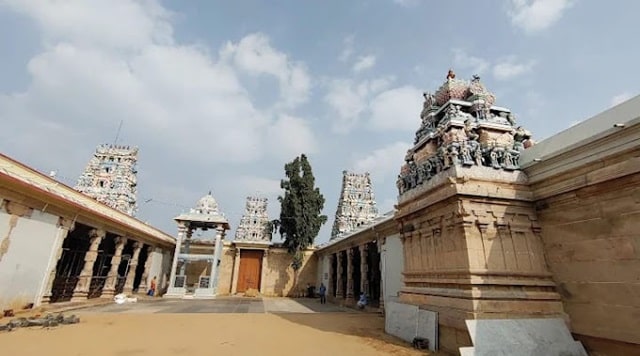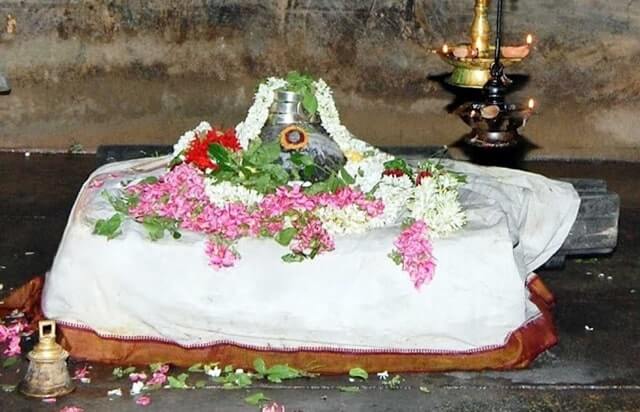- June 5, 2025

Contents
| Temple Name | Kodumudi Magudeswarar Temple |
|---|---|
| Lord Shiva known as | Kodumudinathar |
| Goddess | Soudambikai, Vadivudainayagi |
| Sacred Water | Deva Theertha, Brahma Theertha, Kaveri |
| Puranic Name | Tiruppandikodumudi |
| Sthala Vriksham | Vanni Maram |
| Town | Kodumudi |
| District | Erode |
Thennadudaya Sivane Potri
Ennatavarkum Iraiva Potri
The rolling waters of river Cauvery, flowing north-south, change direction towards the east at the sacred town of Kodumudi. The Kodumudinathar temple is on the western bank. The temple has a magnificent presence. Facing east, it spans over a length of 640 feet and a breadth of 484 feet. The temple boasts of individually planned towers and shrines for the trinity of gods Brahma, Vishnu and Shiva. It has three gateways along the eastern wall. On entering through the middle tower entrance, one can get to the shrines of Mahavishnu and Lord Brahma. The gateway to the left leads one to the darshan of the moolavar (primary God) of this place, Kodumudinathar. Enter through the gate on the south and you would greet the sannidhi (shrine) of the grand and gracious Vadivudai Nayaki or Soudambikai.

Lord Kodumudinaathar here is “Swayambhu” or self-manifested. The lingam is very short in appearance, with its ‘aavudayaar’ or pedestal in the shape of a square. One can see finger-prints on the phallus of the lingam. Ancient stories propose that these finger-prints are of the great sage Agastya, who worshipped the lingam here. In the praharam around the main shrine, there are idols of Narthana Vinayaka, Lord Dakshinamurthy, Mahavishnu, Brahma and goddess Durga. To the right of the main shrine, is that of Amman Vadivudai Nayaki. This sort of arrangement, where the lord and his consort are side by side is specially recognized as a ‘Kalyana Sthalam’ or ‘the seat of marriage’.
The idols of Vallabha Ganapathi, Sozheeswarar, Vishweshwarar, Kashi Vishwanathar, Visalakshi and the sapta maathas add interest to the inner circumambulating passage around the Amman shrine. There is an exclusive shrine dedicated to Goddess Saraswathi. One can also find smaller sannidhis of Maheshwarar, Agastheeshwarar, Gajalakshmi and Lord Muruga here.

At the southeast corner, one can offer prayers to Lord Surya (the sun), and at the northeast corner, to Lord Chandra (the moon). The sun, moon, and planets are given very high importance in Hindu tradition and mythology and their positions/movements are often considered to have a bearing on the course of people’s lives, family and fortunes. Bhairavar and Saneeshwarar shrines are also found in the northern part of the praharam.
Situated behind the temple of the goddess, to the west, is a Vanhi tree, considered to be over 2000 years old. Beneath this tree is the serene shrine of the three-faced Brahma. The tree is considered to be his fourth face. The tree has thorns only on one side, while the other side has none. This tree bears neither flowers nor fruits, and hence is considered to be male. People believe that purity of water can be retained, just by dropping in a leaf or two, of this tree. Devotees who undertake pilgrimage on foot (padayatra) to the Palani temple for the Panguni Uthiram festival, carry water for libation (theertha yatra), preserved by these leaves.

There is also a temple for Perumal to the northwest of the Brahma temple. Here, the lord is in Shayana posture and goes by the names ‘Palli Konda Perumal‘ and ‘Veera Narayana Perumal‘. Adjacent to Perumaal is housed the shrines of Thirumangai Naacchiyaar and Lord Hanuman. Mythological narratives talk about Brahma and Vishnu having prayed to Lord Shiva in this Sthalam.

The holy river, Cauvery and the smaller water sources namely Deva Theertham, Bharadwaja Theertham and Brahma Theertham (next to the madappalli or the temple kitchen) further add to the sanctiity of this place. It is a common belief that one can get cured of physical illnesses and mental ailments such as depression, black-magic, witchcraft etc by taking a holy dip in Cauvery and the Deva Theertham and offering prayers to the Trinity of gods here.
Another story is that King Malayathwaja Pandian had a son who had deformed hands and fingers by birth. He got cured of his deformities after father and son prayed to Lord Kodumudinathar. Malayathwaja Pandian demonstrated his Bhakti (devotion) and gratitude to the Lord by building three gopurams (temple towers) and mantapams (halls) and also organized for a series of special poojas and activities. The place is also referred to as ‘Pandikkodumudi’ or ‘Thiruppandikkodumudi’ as a mark of respect and remembrance of the Pandyan King.

The legend of Agasthyar traveling to the South to tilt the balance of the earth is associated with Paandikkodumudi. It is believed that the waters of his kamandalam flowed from here as the Kaveri river to alleviate the misery of the farmers downstream. The Vinayakar here is referred to as Kaviri Kanda Vinayakar.
This Shivasthalam is situated on the Tiruchirapalli – Karur – Kodumudi – Erode state highway and is about 40 Kms from Erode. The temple is very near to Kodumudi railway station which is on the Erode – Tiruchy section of the Southern Railway.
The Kodumudinathar temple is open for darshan from 06:00 AM to 12:30 PM and from 04:00 PM to 08:00 PM.
Kodumudi Temple Contact Number: Call: 04204 222375
3VGQ+FH8, Kodumudi, Tamil Nadu 638151